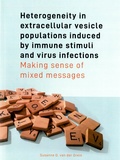Heterogeneity in extracellular vesicle populations induced by immune stimuli and virus infections
Making sense of mixed messages

Grein, Susanne van der
- Promoter:
- Prof.dr. M.H.M. (Marca) Wauben & prof.dr F.J.M. (Frank) van Kuppeveld
- Co-promoter:
- Dr. E.N.M. (Esther) Nolte - 't Hoen
- Research group:
- Extracellular vesicles in the context of viral and bacterial infections , Wauben
- Date:
- February 27, 2020
- Time:
- 16:15 h
Summary
Cells can communicate with each other via the release and uptake of extracellular vesicles (EV). EV are small (50-1000 nm) membrane-enclosed particles which transport lipids, proteins and RNA. Diverse functions have been ascribed to EV in the regulation of the immune system and during pathogenic infections. Furthermore, EV populations are highly heterogeneous in phenotype and molecular composition. In this thesis we investigated the diversity in EV structure and composition, as well as the relation with the functional variety of EV released by immune-regulatory dendritic cells (DC) and cells infected with naked viruses. We show that immune-activating or immune-suppressive (tolerogenic) DC release EV with vastly distinct non-coding RNA content. Moreover, we describe a potential link between the RNA content of EV from tolerogenic DC and their suppressive effects on the release of an inflammatory cytokine by a subset of memory T cells. In addition, we demonstrate that cells infected with picornaviruses release multiple virus-containing and non-virus containing EV populations. These EV differ in physical properties, molecular composition and function, including the capacity to transfer the infection to new host cells. We found strong indications that a viral protein, as well as antiviral defense mechanisms of the host, can play a role in determining the biogenesis route and protein composition of EV. Finally, our data suggest that naked viruses also exist in different EV populations in blood plasma of infected hosts. Our results emphasize the importance of characterizing the structural and compositional heterogeneity of EV populations for studies on EV function.